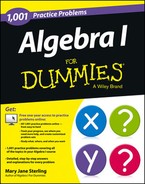Chapter 15
Solving Polynomials with Powers Three and Higher
A polynomial is a smooth curve that goes on and on forever, using input variables going from negative infinity to positive infinity. To solve a polynomial means to set the equation equal to 0 and determine which, if any, numbers create a true statement. Any numbers satisfying this equation give you important information: They tell you where the graph of the polynomial crosses or touches the x-axis.
The Problems You'll Work On
Solving polynomials in this chapter requires the following techniques:
What to Watch Out For
As you probably know, you can come up with a different answer to a math problem by simply confusing or forgetting one step; here are some things to watch out for:
Applying Descartes's Rule of Signs to Count Real Roots
656–659 Count the possible number of positive and negative real roots of the equation.
656. x4 − 3x3 + 2x2 − 4x − 9 = 0
657. x5 − x3 + 4x + 1 = 0
658. 5x4 − 3x3 + 6x − 2 = 0
659. x6 + x4 − x3 + 6x2 − x + 9 = 0
Applying the Rational Root Theorem to List Roots
660–663 List all the possible rational roots for each polynomial equation.
660. x5 + x4 − 4x3 − 2x2 − 4x + 8 = 0
661. 5x4 − 3x2 + 6x − 6 = 0
662. 2x5 − 5x4 + 2x3 − 3x2 + 4 = 0
663. 6x4 − 3x3 + 2x2 + 5x + 3 = 0
Determining Whether Numbers Are Roots
664–667 Check to see which of the given values are roots of the equation.
664. Given x3 − 3x2 + 2x + 24 = 0, check to see whether 2, −2, 3, or 4 is a root.
665. Given x4 − 5x3 + 3x2 + 8x + 3 = 0, check to see whether 1, −1, 3, or −3 is a root.
666. Given x5 − 4x4 − 3x3 + 4x + 2 = 0, determine whether 1, −1, 2, or −2 is a root.
667. Given x6 − x5 + x3 − 2x + 1 = 0, determine whether 1 or −1 are roots.
Solving for the Roots of Polynomials
668–685 Solve for all real roots.
668. x3 + 3x2 − 4x − 12 = 0
669. x3 − x2 − 25x + 25 = 0
670. x3 + 4x2 + x − 6 = 0
671. x3 − x2 − 26x − 24 = 0
672. x4 − 81 = 0
673. x6 − 64 = 0
674. x3 + 7x2 + 8x − 16 = 0
675. x3 − 9x2 + 24x − 20 = 0
676. x4 − 37x2 + 36 = 0
677. x4 − 73x2 + 576 = 0
678. x4 − 4x3 − 3x2 + 10x + 8 = 0
679. x5 − x4 − 22x3 − 44x2 − 24x = 0
680. 4x3 − 9x2 − 4x + 9 = 0
681. 4x3 + 12x2 − 9x − 27 = 0
682. 2x5 + 5x4 − 5x3 − 5x2 + 3x = 0
683. 3x4 − 5x3 − 77x2 + 125x + 50 = 0
684. 8x4 − 30x3 − 51x2 + 263x − 210 = 0
685. 5x5 − 6x4 − 14x3 + 28x2 − 15x + 2 = 0
